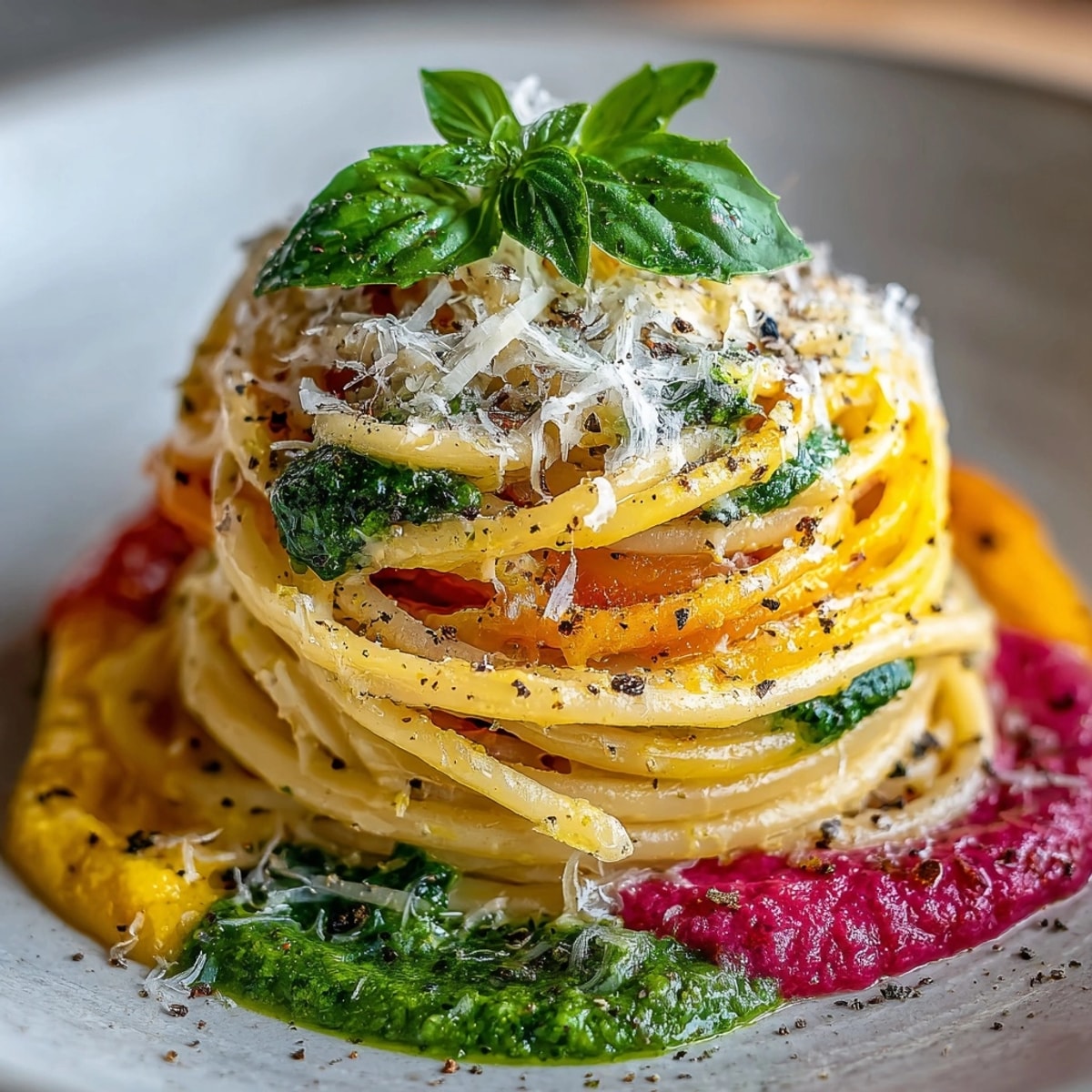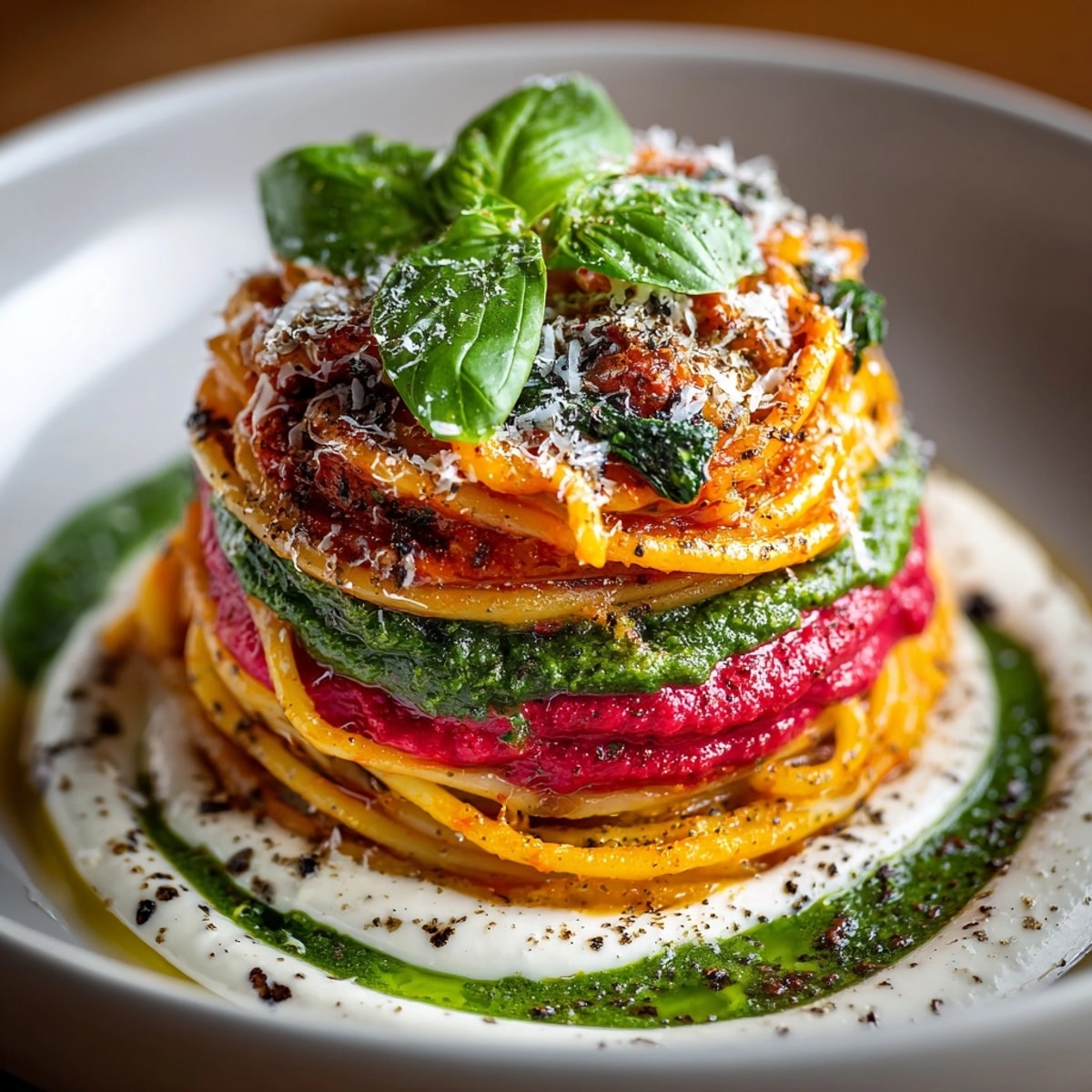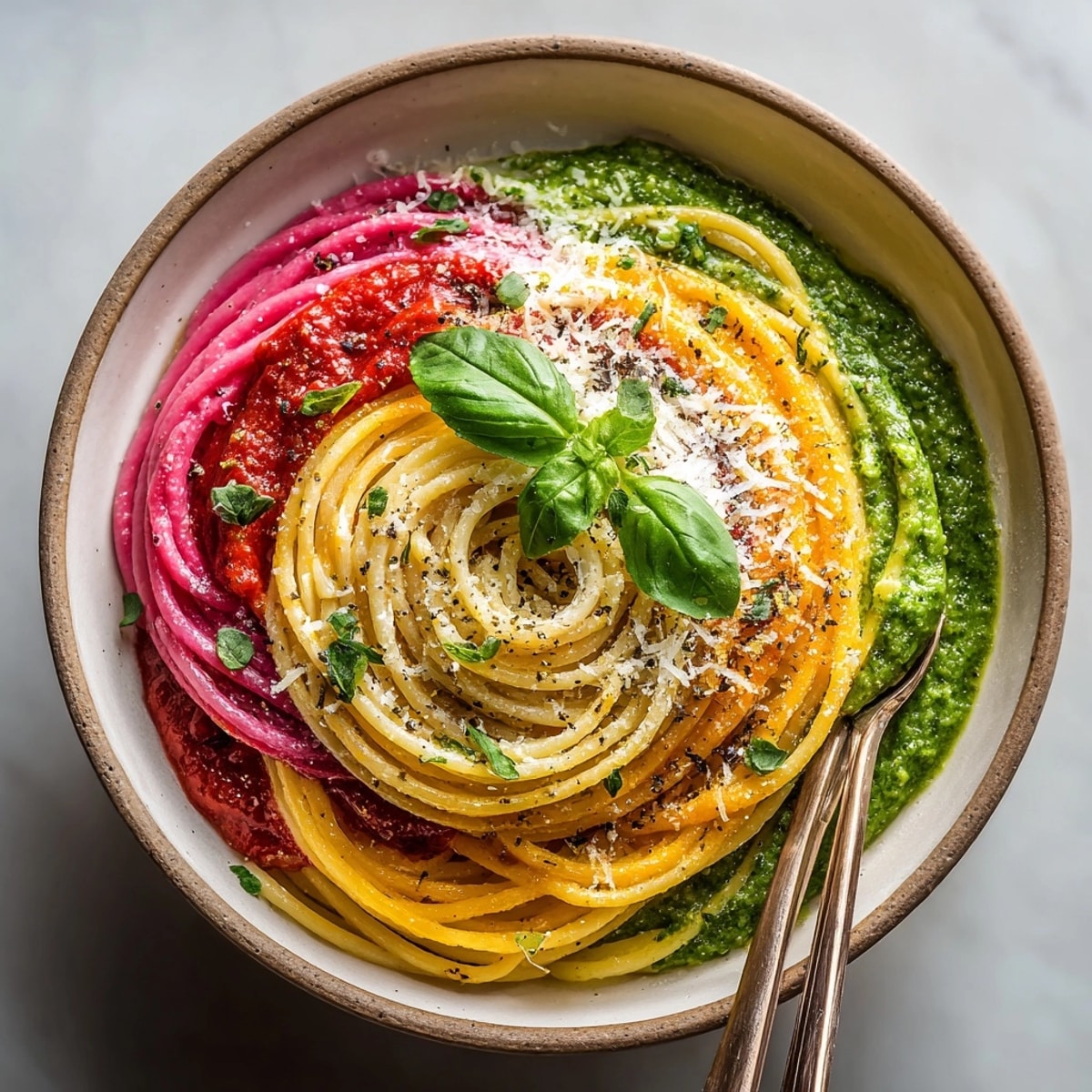 Save
Save This hearty ombre pasta bowl transforms a simple pasta dinner into an artistic masterpiece that will impress anyone at your table. The gradient sauce technique creates a stunning visual effect while offering a delicious range of complementary flavors in every bite.
I first created this dish for a dinner party when I wanted something that would make my guests gasp when it arrived at the table. The colorful sauce gradient has since become my signature dish for special occasions when I want to elevate pasta night without spending hours in the kitchen.
Ingredients
- Dried spaghetti or linguine: 400 g Quality matters here as it forms the base of the dish
- Olive oil: 1 tbsp Prevents pasta from sticking after cooking
- Salt for pasta water: Essential for properly seasoned pasta
- Béchamel sauce: 1 cup Creates the creamy white base for lighter sauces
- Tomato passata: 1 cup Provides vibrant red color and sweet tomato flavor
- Roasted red pepper purée: 1 cup Adds depth and smoky notes to the gradient
- Basil pesto: 1/2 cup Brings herbal freshness and beautiful green color
- Spinach purée: 1/2 cup Intensifies the green section and adds nutrients
- Heavy cream: 1/4 cup Lightens the béchamel for the palest sauce section
- Grated Parmesan cheese: 40 g Adds umami richness and beautiful garnish
- Fresh basil leaves: Brightens the final presentation with pops of green
- Cracked black pepper: Provides visual contrast and gentle spice
Instructions
- Prepare the Pasta:
- Cook the pasta in generously salted water until perfectly al dente according to package directions. The pasta should have a slight bite as it will continue to absorb sauce. Drain thoroughly then toss immediately with olive oil to prevent sticking. Cover to keep warm while preparing the sauces.
- Create the Gradient Sauces:
- Prepare each sauce in separate small saucepans. For the lightest sauce combine half cup béchamel with quarter cup heavy cream for a silky white base. Next make the pink sauce by mixing half cup béchamel with half cup tomato passata until perfectly blended. For the red sauce use straight tomato passata seasoned well with salt and pepper. Create the deep red sauce by combining roasted red pepper purée with quarter cup tomato passata for a rich burgundy tone. Finally mix half cup pesto with half cup spinach purée for the vibrant green sauce.
- Warm the Sauces:
- Gently heat each sauce over low heat stirring occasionally. The sauces should be warm but not bubbling which would change their consistency. Keep temperatures low and stir frequently to prevent scorching especially with the cream based sauces.
- Assemble the Ombre Effect:
- Begin with a large shallow bowl and mound the warm pasta in the center. Using a soup spoon carefully drizzle each sauce in distinct sections starting with the lightest cream sauce and progressing through pink red deep red and finally green. Allow the edges of each sauce to gently blend into the next for the true ombre effect. The sauces should partially cover the pasta while also creating a beautiful pattern in the bowl.
- Final Garnishing:
- Sprinkle freshly grated Parmesan cheese over the entire dish focusing slightly more on the center pasta mound. Arrange fresh basil leaves strategically for pops of green. Finish with a generous amount of freshly cracked black pepper across the entire dish for visual contrast and flavor enhancement. Serve immediately while the sauces are still warm and the visual effect is at its most stunning.
 Pin it
Pin it The roasted red pepper purée completely transformed this dish for me. I discovered its deep smoky flavor created the perfect transition between the tomato and herb sauces. My daughter now requests this pasta for her birthday dinner every year saying it looks like an edible sunset in a bowl.
Storage and Reheating
While this dish is best enjoyed fresh after assembly the components can be stored separately for excellent results. Store each sauce in airtight containers in the refrigerator for up to 3 days. When reheating gently warm sauces in small saucepans over low heat adding a slash of cream or broth if they've thickened. Prepare fresh pasta for reassembly as reheated pasta often becomes too soft for the best presentation.
Sauce Variations
The beauty of this technique lies in its adaptability to different color palettes and flavor profiles. Try a yellow sauce using puréed yellow bell peppers or saffron cream. Create a purple section with roasted beet purée blended with a touch of cream. For a blue tone incorporate butterfly pea flower tea into a white sauce base. The key is maintaining similar sauce consistencies so they flow and blend properly on the plate.
Serving Suggestions
This impressive dish deserves thoughtful accompaniments. Serve alongside a simple arugula salad dressed with lemon and olive oil to cut through the richness. Warm crusty bread is perfect for sopping up the beautiful sauces. For wine pairings choose a crisp white like Pinot Grigio or Sauvignon Blanc that won't overwhelm the delicate gradient of flavors.
Historical Context
While this modern presentation technique has gained popularity through social media and fine dining restaurants the concept draws from Italian cuisine's regional diversity. Traditional Italian cooking often features distinct regional sauces from the cream based preparations of the north to the tomato centric recipes of the south. This dish pays homage to that diversity by showcasing multiple sauce traditions in one harmonious presentation.
Seasonal Adaptations
Spring version uses asparagus purée and pea shoots for bright green elements Summer adaptation incorporates yellow tomato sauce and fresh herbs Fall variation features pumpkin cream sauce and sage infused oils
Success Stories
This ombre pasta technique has become my most requested dinner party dish. Guests always ask for the recipe and are shocked by how approachable it actually is. One friend served it at her anniversary dinner and her husband was convinced she had ordered takeout from an upscale restaurant! The visual impact truly belies the reasonable effort required to create it.
 Pin it
Pin it The ombre pasta bowl is a stunning visual feast and a delight to eat. Its impressive presentation is surprisingly achievable for any home cook.
Frequently Asked Questions
- → How do I achieve the gradient effect with sauces?
Spoon each warmed sauce onto the pasta in overlapping sections, starting with the lightest and progressing to darker and green hues, gently blending at the edges for a smooth transition.
- → Can I make this dish vegan?
Yes, use plant-based cream, béchamel, and cheese, and ensure the pesto is dairy-free for a fully vegan version.
- → What type of pasta works best?
Spaghetti or linguine are recommended, but any long pasta shape works well to showcase the layered sauces.
- → How should I serve the ombre pasta bowl?
Use a large, shallow bowl and arrange the sauces distinctively before garnishing with Parmesan, basil, and pepper for maximum visual impact.
- → Can I prepare the sauces in advance?
Yes, make the sauces ahead and reheat gently before assembling the bowl to save time and ensure smooth blending.
- → Are there garnish variations?
Try fresh herbs, microgreens, or even roasted beet purée for added color and flavor variations.